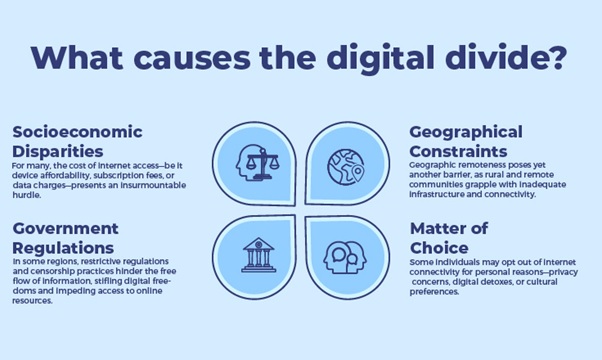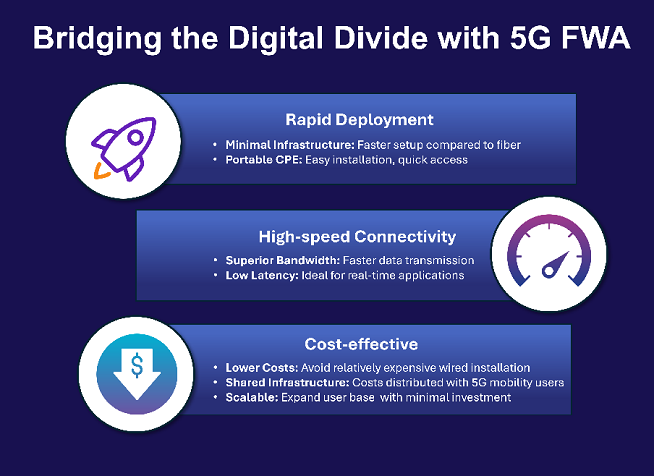In April 2024, the global internet user count hit a staggering 5.44 billion, representing 67.1% of the world's population (Source- Statista). While this number is impressive, it begs the question: what about the remaining 32.9%? This discrepancy prompts a crucial question: why are millions still left stranded on the digital sidelines? Another aspect to consider is that, while mobile internet connectivity might be available, the number of households with true broadband internet is crucial. True broadband is essential for providing services that can effectively bridge the digital divide. Although there may be hundreds of reasons for this internet disparity, closing the digital divide must be a top priority. Technologies such as 5G Fixed Wireless Access (5G FWA) are making significant strides in bridging this gap by providing high-speed broadband internet access to remote and rural areas where traditional broadband infrastructure is either unavailable or prohibitively expensive. By leveraging existing cellular networks, 5G FWA can deliver reliable internet connectivity, thereby enhancing opportunities for education, employment, and social inclusion.

Why 5G Fixed Wireless Access (FWA) is best positioned for bridging the digital divide?
Various technologies make broadband internet available to both urban and rural households. Traditionally, copper cables were used to provide wired broadband connections, but they are now being replaced by fiber cables, which are cheaper and offer much superior bandwidth. Additionally, emerging technologies like satellite broadband and High-Altitude Platform Systems (HAPS) aim to meet these needs.
However, fixed wireless access, which operates on the mid-band (sub-6GHz) spectrum, has emerged as the most effective and rapid solution to bridge the digital divide. Let's examine some key attributes that contribute to its effectiveness.
Rapid Deployment:
5G Fixed Wireless Access requires less physical infrastructure compared to laying fiber-optic cables to individual households. This makes it quicker and more cost-effective to deploy, especially in areas where laying cables is challenging. Setting up 5G FWA at user premises is relatively straightforward, often requiring a highly portable Customer Premise Equipment (CPE) which receives the 5G signal from the base station and distributes it as Wi-Fi or Ethernet connection inside the home. This simplicity reduces the need for extensive civil engineering work typically required to lay fiber or copper cables for the last mile to homes. As a result, deployment is faster, providing communities in need with rapid access to high-speed internet
High-speed Connectivity:
5G networks offer significantly higher bandwidth compared to previous generations, enabling faster data transmission rates. This allows users to access high-speed internet similar to what is available through fiber-optic connections. For instance, with 5G, you could download a full-length HD movie in a matter of seconds. The low latency capability of 5G networks is crucial for applications requiring real-time data transmission, such as video conferencing, telemedicine, and, tele-education, ensuring reliable connectivity for users, even in highly demanding scenarios.
Cost-effectiveness:
In most of the geographies such as North America and Europe, typical costs of laying underground Fiber range from $11 to $24 per foot for underground deployment and $4 to $9 per foot for aerial deployment (Source - Cartesian) subject to government regulations. In these geographies, the majority of the costs associated with laying fiber are due to labor. In other countries with lower labor costs, factors such as right-of-way, terrain, and population density make laying fiber prohibitively expensive. Therefore, in general, fiber-optic cabling emerges as the costlier option compared to 5G FWA deployment. 5G Fixed Wireless Access (FWA) eliminates the need for extensive cabling, significantly reducing the costs associated with providing high-speed internet. 5G network infrastructure is shared with mobility customers distributing the associated costs and making the business case for FWA more compelling. 5G FWA's scalability enables it to accommodate growing numbers of users with minimal additional infrastructure investment.

Challenges associated with 5G Fixed Wireless Access
Spectrum Availability:
Effective deployment of 5G FWA requires adequate spectrum allocation in the sub-6 GHz range. The spectrum is a scarce resource and has to be judiciously allocated. Each country has been making it available in different quantities based on their existing usage and requirements. However, governments and regulatory bodies must ensure that sufficient spectrum is available for 5G services as they have the potential to affect the lives of people in more significant ways than was possible earlier.
Upfront Infrastructure Investment:
One of the challenges that telecom operators face concerning 5G is upfront investments in infrastructure and spectrum costs without immediate returns on their investments. Telcos have to spend upfront on:
- Base Stations: While 5G FWA reduces the need for physical cabling, it still requires a network of radio base stations that provide the 5G coverage of the population at large. Significant investment in these base stations is necessary and varies based on the terrain and population of the country. The upfront investment in spectrum and radio base stations needs to be suitably financed and governments/regulators have to address the need for this infrastructure to be built for rural populace along with urban areas.
- Backhaul Connectivity: Ensuring that base stations have robust backhaul connectivity, often through fiber-optic networks, is essential for maintaining high-speed internet delivery. Backhaul fiber optic networks should be considered national assets and constructed in a manner that allows telecommunications companies to set up radio base stations in rural areas without worrying about immediate returns on their investments. This approach would ensure that rural populations have access to services comparable to those available in urban areas
Future Prospects
Technological Advancements: mmWave Spectrum Utilization
Continued advancements in 5G technology, including improvements in hardware and software to allow usage of higher frequency spectrums such as in 24-32 GHz (mmWave), will enhance the capabilities and efficiency of 5G FWA. The bandwidth at these higher frequencies is much higher allowing headroom for growth of the broadband internet traffic. Combining 5G FWA with other emerging technologies, such as edge computing and Internet of Things (IoT) devices, can provide comprehensive solutions for marginal communities and rural populations.
Policy and Regulation:
Government policies that support the deployment of 5G infrastructure, including subsidies and incentives for service providers, can accelerate the adoption of 5G FWA. Developing clear and supportive regulatory frameworks is crucial for managing spectrum allocation, ensuring fair competition, and protecting consumer interests.
Community Engagement:
Engaging local communities in the planning and deployment of 5G Fixed Wireless Access can ensure that the technology meets the specific needs of different areas. Collaboration between governments, private companies, and non-profit organizations can create sustainable models for expanding internet access.
Conclusion
Emerging technologies like 5G Fixed Wireless Access (FWA) are playing a crucial role in bridging the digital divide. By offering high-speed broadband internet access in areas where traditional wired connections are impractical, 5G Fixed Wireless Access can revolutionize connectivity for remote and rural regions. However, technology alone cannot solve the problem. A holistic approach is essential—one that includes policy reforms, private-sector investment, and community-driven initiatives. Only by addressing the digital divide on all fronts can we ensure that everyone has the opportunity to participate in the digital economy and benefit from the transformative power of the internet.